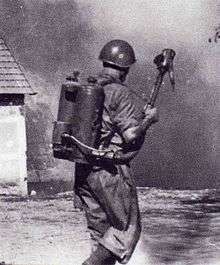Lanciafiamme Modello 35
| Lanciaflamme Modello 35 | |
|---|---|
|
| |
| Type | Flamethrower |
| Place of origin | Kingdom of Italy |
| Service history | |
| In service | 1935-1945 |
| Used by |
Royal Italian Army Finland |
| Wars |
First Italo-Ethiopian War Second Italo-Ethiopian War World War II |
| Production history | |
| Designed | 1935 |
| Manufacturer | Servizio Chimico Militare |
| Number built | 1500 |
| Specifications | |
| Weight | 27 kg full, 10 kg empty |
|
| |
| Effective firing range | 20 m |
| Filling | 12 liters of flammable liquid + 6 liters of propellent gas |
The Lanciafiamme Spalleggiato Mod. 35 is a flamethrower that was issued to the Royal Italian Army in the Second Italo-Ethiopian War. In 1940 it was replaced by the Lanciafiamme Spalleggiato Mod. 40,[1] which differed in the ignition system.
History
The Mod. 35 was adopted by the Royal Italian Army in 1935 and assigned to a "Flamethrower Platoon", each with 3 squads, consisting of 6 sections with 2 weapons each.[2] In 1939, 176 copies of this model were sold to the Finnish army that employed it under the name Liekinheitin M/40 to be used against the Red Army during the Winter War. In the First Italo-Ethiopian War, during the outbreak of WWII, the Liekinheitin M/40 was issued to the division at the Greek-Albanian front. During the war, Mod. 40 was issued mostly to the Italian sappers "Guastatori"[2] and also employed in North African Campaign and in Russia.
Compared to contemporary models, the Liekinheitin M/40 is heavier and, compared to the German models, has less range.
Description
Mod. 35

The Mod. 35 is essentially composed of three elements: the tank, the lance, and the ignition system.
The tank, carried via two transport belts and padded back, was composed of two cylinders. Each was divided internally into two parts by a metal diaphragm. The two superior sections were linked together and could hold 6 liters of nitrogen at 20 atm, which acted as a propellant. The lower halves, which were also connected, contained 12 liters of fuel. This was a mixture composed of 9 parts of diesel oil and 1 part gasoline.[2] Both fuels were loaded from special openings on the upper end of the cylinders, where there is also a manual valve which conveyed the liquid nitrogen in the tank to put them under pressure at the moment of use. The filler pipe coupling of the lance was located in the lower, laterally to the right cylinder.
The lance has a control lever that is manufactured from a lightweight alloy, and this connects to the tank through a hose. At the muzzle of the lance, a large flange ("cartoccia") has a double ignition system. The main system was initially made up of two sharpening steels, with flint and rollers to friction, actuated by the control lever. It was later replaced by an electrical system: a square box, placed posterior to the cylinders houses an 18 volt battery with a dynamo for manual recharging. Two electric cables run along the manifold and the lance up to the flange, each supplying a common automotive spark plug. The spark ignites the jet. The subsidiary system consists of the so called "bengalotto", that is, a slow-burning pyrotechnic device that is manually ignited and mounted on the weapons sight, burning for 2 minutes. On the passage of the flammable liquid jet, operated by the lever on the lance, the jet burst into flames forming a dart of 20 meters, which produced a deep unbearable heat zone 35 meters wide and 15.[2] The system of "bengalotto", though simple and reliable, had the defect of prematurely revealing the position of the weapon.
The weapon was carried by two soldiers, flammieri, protected by fireproof vests. The system, due to its weight and the overall dimensions of the fireproof suit, could be carried on the back only for short distances, being normally transported on trucks or on special donkey saddle. The flammable liquid reserves allowed about 20 short throws.[2] Charging takes 20 minutes.


Mod. 40
The Mod. 40 carries an improved electrical ignition system. This was made from a high-voltage magnet activated by a turbine flow, set in motion by the flow of the liquid fuel under pressure at the time of launch, positioned posterior to cylinders in a cylindrical container. The electrical connection fed the spark plug and ignites the jet. The flange still retained the bengalotto tube as an adjunct ignition system. For the rest, components and performance remained unchanged.
Further developments
The excessive weight of the system on the battlefield, led during the war the development of the Lanciafiamme Mod. 41, lighter and with a slightly modified electrical system. To the shock troops and paratroopers it was also further developed a lighter version, that could be held as a rifle, called Lanciafiamme Mod. 41 d'assalto. The Italian armed forces also used, besides the flame thrower installed on tanks, the Lanciafiamme Carrellato Mod. 42,[2] a heavy model intended for engineers rather than assault troops.
See also
- Flamethrower
- Lanciafiamme Modello 41
- Lanciafiamme Modello 41 d'assalto
- T-148/B
Notes
- ↑ Official denomination taken from Istruzione per l'addestramento e l'impiego di unità lanciafiamme, Direzione del Servizio Chimico Militare, Ministero della Guerra, 1943.
- 1 2 3 4 5 6 Nicola, Pignato (1971). Le armi della fanteria italiana nella seconda guerra mondiale. Italy: Ermanno Albertelli Editore. p. 68. OCLC 797573113.
Bibliography
- Le armi della fanteria italiana nella seconda guerra mondiale, Nicola Pignato, Albertelli Ed., 1978.
- Tactical and Technical Trends, United States Department of War, n. 34, 1943.